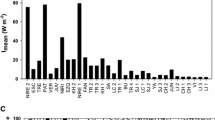Abstract
Data for comparison are from 17 dimictic and four polymictic lakes interconnected to form a system of the Great Masurian Lakes. Both summer epilimnetic total phosphorus and chlorophyll were higher in dimictic than in polymictic lakes. Chlorophyll was probably not limited either by phosphorus or by nitrogen in shallow lakes. Utilization of phosphorus in terms of chlorophyll:particulate phosphorus and chlorophyll:particulate nitrogen ratios was similar in the two groups of lakes. Significant differences were found, however, in the chlorophyll:seston ratio, higher in dimictic lakes. These observations together suggest that seston in shallow lakes contains a significant, though unpredictable contribution of detritus/mineral particles much poorer in phosphorus than those in dimictic lakes. Secchi disc depth was better explained in shallow lakes by seston variability than by chlorophyll. Thus, algal production in shallow masurian lakes seems to be limited by light conditions resulting from resuspension of non-living particles while the production in deep lakes is nutrient (both nitrogen and phosphorus) limited.
Similar content being viewed by others
References
Carlson, R. E., 1977. A trophic state index for lakes. Limnol. Oceanogr. 22: 361–369.
Dokulil, M. T. & J. Padisak, 1994. Long-term compositional response of phytoplankton in a shallow, turbid environment, Neusiedlersee (Austria/Hungary). Hydrobiologia 275/276: 125–137.
Edmondson, W. T., 1991. The uses of ecology: Lake Washington and beyond. Univ. Washington Press: 329 pp.
Golterman, H. L., 1969. Methods for chemical analysis of fresh waters. Blackwell Scientific Publications, Oxford and Edinburgh: 172 pp.
Hillbricht-Ilkowska, A., I. Kostrzewska-Szlakowska & R. J. Wi´sniewski, 1996. Zró´znicowanie troficzne jezior rzeki Krytuni (Pojezierze Mazurskie) – stan obecny, zmienno´sPc wieloletnia, zale´zno´sci troficzne. (Trophic differentiation of lakes along River Krutynia (Masurian Lakeland) – present situation, long-term variability and trophic relationships). In: Hillbricht-Ilkowska, A. & R. J. Wi´sniewski (eds), The Functioning of River-Lake System in a Lakeland Landscape: River Krutynia (Masurian Lakeland, Poland). Zesz. Nauk. Komitetu ‘Czlowiek i Srodowisko’ PAN, 13: 125–153.
Jensen, H. S. & F. Ø. Andersen, 1992. Importance of temperature, nitrate and pH for phosphate release from aerobic sediments of four shallow, eutrophic lakes. Limnol. Oceanogr. 37: 577–589.
Kleeberg, A. & H.-P. Kozerski, 1997. Phosphorus release in Lake Grosser Mueggelsee and its implications for lake restoration. Hydrobiologia 342/343: 9–26.
Knuuttila, S., O.-P. Pietiläinen & L. Kauppi, 1994. Nutrient balances and phytoplankton dynamics in two agriculturally loaded shallow lakes. Hydrobiologia 275/276: 359–369.
Królikowska, J., 1997. Eutrophication processes in a shallow, macrophyte dominated lake-species differentiation, biomass and the distribution of submerged macrophytes in Lake Łuknajno (Poland). Hydrobiologia 342/343: 411–416.
Kufel, I. & L. Kufel, 1997. Eutrophication processes in a shallow macrophyte-dominated lake:nutrient loading to and flow through Lake Łuknajno (Poland). Hydrobiologia 342/343: 387–394.
Kufel, L. & T. Ozimek, 1994. Can Chara control phosphorus cycling in Lake Łuknajno (Poland)? Hydrobiologia 275/276: 277–283.
Kufel L., J. Królikowska & I. Kufel, 1996. Structure of submerged littoral vegetation in relation to pelagic trophic state indices. Ekol. pol. 44: 293–310.
Kufel, L., 1998. Chlorophyll–nutrients–Secchi disc relationships in the Great Mazurian Lakes (north-eastern Poland). Pol. J. Ecol. 46: 327–337.
Lijklema, L., 1994. Nutrient dynamics in shallow lakes:effects of changes in loading and role of sediment-water interactions. Hydrobiologia 275/276: 335–348.
Nixdorf, B. & R. Daneke, 1997. Why `very shallow’ lakes are more successful opposing reduced nutrient loads. Hydrobiologia 342/343: 269–284.
Pridmore, R. D., J. E. Hewitt & A. B. Cooper, 1989. Does the chlorophyll acontent of phytoplankton vary with trophic status in lakes on the New Zealand central volcanic plateau? J. Plankton Res. 11: 583–593.
Scheffer, M., 1998. Ecology of shallow lakes. Chapman & Hall, London, Weinheim, New York: 357 pp.
Scheffer, M., S. H. Hosper, M.-L. Meijer, B. Moss & E. Jeppesen, 1993. Alternative equilibria in shallow lakes. Trends Ecol. Evol. 8: 275–279.
Solórzano, L., 1969. Determination of ammonia in natural waters by the phenylhypochlorite method. Limnol. Oceanogr. 14: 799–800.
Standard methods for the examination of water and waste water. 1960. Am. Publ. Health Assoc. Inc., New York: 626 pp.
White, E., G. Payne & S. Pickmere, 1988. A limitation to the usefulness of chlorophyll as a biomass indicator in eutrophication studies. Verh. int. Ver. Limnol. 23: 598–601.
Zdanowski, B., 1982. Variability of nitrogen and phosphorus contents and lake eutrophication. Pol. Arch. Hydrobiol. 29: 541–597.
Author information
Authors and Affiliations
Rights and permissions
About this article
Cite this article
Kufel, L. Dimictic versus polymictic masurian lakes: similarities and differences in chlorophyll-nutrients–SD relationships. Hydrobiologia 408, 389–394 (1999). https://doi.org/10.1023/A:1017067406035
Issue Date:
DOI: https://doi.org/10.1023/A:1017067406035




